You are using an out of date browser. It may not display this or other websites correctly.
You should upgrade or use an alternative browser.
You should upgrade or use an alternative browser.
From Freightliner ambulance to RV - we hope!
- Thread starter rossvtaylor
- Start date
rossvtaylor
Adventurer
Even though the clock is not running, does the display still respond to the settings and count down as it's cooking?
Yup! It did everything we wanted, without the annoyance of the flashing unset clock. I have NO idea how it will hold up under travel conditions, but for $60 it's a nice little microwave.
Now, as far as the real cooking and the rest of the kitchen goes... We'll have a coffee maker inside. Something with a metal carafe, like the Bodum Bistro we have in our office maybe? It only uses energy while making the pot, then the coffee stays hot in a thermal carafe which won't break. We also looked at the Coffee Boxx units. They are nice looking. I've used the refillable K-Cup pods before and they work well. But the Bodum works well for us at the office and it looks like a good option for travel.
For real cooking, we'll be outside. In one of the rear/side compartments, most likely the right rear, we'll put in a small stainless grill and a stainless propane stove. A Partner, maybe? We'll also put a dish and hand washing sink back there. We don't plan to cook inside unless there's no other option.
rossvtaylor
Adventurer
Does anyone know what the "stock" battery arrangement or requirement is for this FL series truck? One of the battery retailer sites lists a 775 CCA group 31 battery as the stock battery, but is that just one or 2 or 4? I've looked online and in the driver's manual, with no joy... Next stop is our Freightliner service center, if needed, but they've not been that helpful so far.
There's a place under the driver's door, where a battery tray lives in some versions. If a single battery there is "stock" then we'll add one and separate out the bank of 4 batteries we've also got, in the driver's side step slide-out tray. But, we don't want to do anything until I can find if one battery is enough for starting.
Thanks!
There's a place under the driver's door, where a battery tray lives in some versions. If a single battery there is "stock" then we'll add one and separate out the bank of 4 batteries we've also got, in the driver's side step slide-out tray. But, we don't want to do anything until I can find if one battery is enough for starting.
Thanks!
Ozrockrat
Expedition Leader
You might want to reconsider splitting the house and start batteries up. If you stick with your 4 batteries for both uses you have a lot more discharge capacity which is a lot more friendly to the batteries. You eliminate any charging issues and I have found that I don't have any issues running 2 fridges and lighting full time with the assistance of 280w of solar.
Given that you will have a generator I would suggest just making sure you have the ability to charge your batteries from shore power/generator and leave well enough alone.
Before we had solar I could get 2 days with lighting and fridge without impacting our ability to start the truck even in freezing temps.
The extra capacity of the 4 battery bank becomes even more important if you are putting high current loads on such as a winch or inverter (microwave, coffee machine).
I am sure you can find plenty of other projects to take up you time without modifying a system that works fine. Remember my mantra about the art of maintenance induced failure. If it's not broken you increase the likelihood of failure as soon as you touch it. (How's that for putting it politically correctly)
Given that you will have a generator I would suggest just making sure you have the ability to charge your batteries from shore power/generator and leave well enough alone.
Before we had solar I could get 2 days with lighting and fridge without impacting our ability to start the truck even in freezing temps.
The extra capacity of the 4 battery bank becomes even more important if you are putting high current loads on such as a winch or inverter (microwave, coffee machine).
I am sure you can find plenty of other projects to take up you time without modifying a system that works fine. Remember my mantra about the art of maintenance induced failure. If it's not broken you increase the likelihood of failure as soon as you touch it. (How's that for putting it politically correctly)
Last edited:
rossvtaylor
Adventurer
Well, we certainly have enough projects to keep us busy! Your thoughts and perspective are helpful, and they give me pause to think. And it's nice to have your experience with your bank life. I want to learn more about your solar panels - we looked at some flexible ones, which seem like a good option. But, I'm still leaning towards separate banks. Here's why... first, I like the idea of having a back-up in case we run the bank down. It's nice, to me, to have a separate engine starting battery. We're pretty sure the big diesel genny is going away and we'd like to have a dedicated bank for the house. And, finally, I'm pretty familiar with batteries... I've taught classes (in both private and public college-level institutions) in battery bank design and I'm still involved in the occasional off-grid system design, with a battery bank. The starting battery doesn't generally get discharged deeply (one hopes!) and most won't survive long under the deep-cycle use of a true off-grid system. I see folks all the time, some even here in other Expedition Portal areas, lament the short life of their "deep cycle" battery which was, in reality, just a marine battery with the words "deep cycle" on it. True, those are better than car batteries - but not by much. And they're not true deep cycle batteries. I'm not going so far as to put big tall L16s in this rig, but we are looking at placement options for the future.
We don't plan to make any such change in the near future. We want to get this rig livable and usable and have it out on the road in July. We'll keep the current battery arrangement as is, for the near term. But, we are thinking ahead and planning a place for some more battery capacity. So, if adding a separate starting battery under the driver's side cab is all the Cummins needs, then that frees up that 4-battery tray for future use. And that, of course, then frees up the other places were considering. Or, another alternative... we can move the house batteries rearward and put another diesel tank under the driver's site step.
Nothing soon, but we are trying to think ahead. Thanks for all your help, Ozrockrat and Patoz and MNtal and rlrenz and others, too.
We don't plan to make any such change in the near future. We want to get this rig livable and usable and have it out on the road in July. We'll keep the current battery arrangement as is, for the near term. But, we are thinking ahead and planning a place for some more battery capacity. So, if adding a separate starting battery under the driver's side cab is all the Cummins needs, then that frees up that 4-battery tray for future use. And that, of course, then frees up the other places were considering. Or, another alternative... we can move the house batteries rearward and put another diesel tank under the driver's site step.
Nothing soon, but we are trying to think ahead. Thanks for all your help, Ozrockrat and Patoz and MNtal and rlrenz and others, too.
rossvtaylor
Adventurer
All the 8.3's I have been around used 2 batteries for starting and vehicle loads. Most were the 775 CCA models. A 5.9 starter uses 425 amps on cranking. The 8.3's I have checked were around 600 amps.
Thanks! Were those two batteries beneath the driver's side cab? I'll need to measure to see if two will fit.
Last edited:
cooling/heating issues
Speaking from experience, black will be a poor choice of colors unless some modifications are done. We had an ambulance converted years ago and painted it black. It looked great but was nearly impossible to cool. Our current ambulance conversion is white and still is a giant heat/cold soak to the interior. The problem is that the wall structure is aluminum and most manufacturers use square aluminum tubing for the "studs". They are then covered with aluminum on the exterior and an aluminum sheet covered with formica on the interior. This structure completes an excellent way for heat and cold to be transferred to the interior. While we can keep it cool and warm it does present a challenge. In the southwest last August in 100 degree heat the interior walls were very warm and on cold Colorado nights noted to be cold. There is no insulation in the tube "studs". Our next build will be lined with 1/2 or 3/4" of high performance insulation sheet in place of the current interior lining plus blown in place urethane between the studs after wiring and plumbing is installed. My advice-insulate many times better than you ever think you will need. You will never ever regret it. Someday I will post a thread outlining our 3 year build. It has served us well but we learn from each one.
Speaking from experience, black will be a poor choice of colors unless some modifications are done. We had an ambulance converted years ago and painted it black. It looked great but was nearly impossible to cool. Our current ambulance conversion is white and still is a giant heat/cold soak to the interior. The problem is that the wall structure is aluminum and most manufacturers use square aluminum tubing for the "studs". They are then covered with aluminum on the exterior and an aluminum sheet covered with formica on the interior. This structure completes an excellent way for heat and cold to be transferred to the interior. While we can keep it cool and warm it does present a challenge. In the southwest last August in 100 degree heat the interior walls were very warm and on cold Colorado nights noted to be cold. There is no insulation in the tube "studs". Our next build will be lined with 1/2 or 3/4" of high performance insulation sheet in place of the current interior lining plus blown in place urethane between the studs after wiring and plumbing is installed. My advice-insulate many times better than you ever think you will need. You will never ever regret it. Someday I will post a thread outlining our 3 year build. It has served us well but we learn from each one.
rossvtaylor
Adventurer
Thanks, rwelker, for the input and your experience. The promotional use planned for ours will dictate the exterior color. It's definitely a compromise, we know. Hopefully the only one we'll need to make, right? HAHA! I'm sure if we were going for complete practicality, we'd stay white. Hopefully we don't bake... But, we do need the business "look" to this and we're willing to make the tradeoff, or at least try it, in the interest of making this a legitimate business vehicle.
Get on that build thread! I want to read it and I'm sure we're not alone in that.
As far as what we've accomplished recently... it's not much. With our jobs and family stuff, I don't expect we'll get much done until July. But, I did replace a bad dimmer. The panel dimmer switch was fried and so overheated that the plastic was degrading to powder. I found a switch on eBay. It wasn't from an FL, so it had a different connector. The dimmer itself, though was the right size and resistance range.
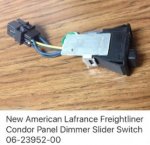

The blue (3-pin) connector is the one in our ambulance, the black (6-pin) connector came on the switch.
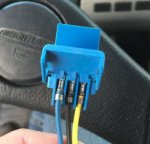

Fortunately, these kinds of connectors open up. Both had a little snap-down cover, which can be opened if you use a knife or thin screwdriver to release the tabs which hold the cover closed. The wires are crimped into pins, which are pushed into their positions and held by a little metal tab. You can use a jewelers screwdriver, from the pin end, to push the tab down. Or, a good stead pull from the wire end will usually free them. That's what worked here. Note the colors and positions in the 3-pin connector and put the wires from the new switch into the 3-pin connector, in the same orientation, then snap the cover closed.
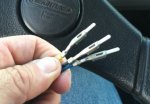
And, our tires arrived via FedEx freight!

Next to the current wheels and tires, they look huge to us.
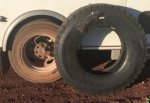
8-year-old Ruby gives some scale to the tire size.

And, finally, standing in place... seeing the tires like this gives us an idea of how much better the rig will look (which is important, of course) but also how much more ground clearance we'll have after they're installed and the suspension is lifted.

Next step? Jack the truck up, put it on blocks, and remove all 7 tires and wheels. They're going to Phoenix, tomorrow, where a buyer is taking them off our hands. KETO 1 will need to sit, immobile, until we get the suspension work done and do some fender well trimming. But that's exciting stuff for us.
Get on that build thread! I want to read it and I'm sure we're not alone in that.
As far as what we've accomplished recently... it's not much. With our jobs and family stuff, I don't expect we'll get much done until July. But, I did replace a bad dimmer. The panel dimmer switch was fried and so overheated that the plastic was degrading to powder. I found a switch on eBay. It wasn't from an FL, so it had a different connector. The dimmer itself, though was the right size and resistance range.


The blue (3-pin) connector is the one in our ambulance, the black (6-pin) connector came on the switch.


Fortunately, these kinds of connectors open up. Both had a little snap-down cover, which can be opened if you use a knife or thin screwdriver to release the tabs which hold the cover closed. The wires are crimped into pins, which are pushed into their positions and held by a little metal tab. You can use a jewelers screwdriver, from the pin end, to push the tab down. Or, a good stead pull from the wire end will usually free them. That's what worked here. Note the colors and positions in the 3-pin connector and put the wires from the new switch into the 3-pin connector, in the same orientation, then snap the cover closed.

And, our tires arrived via FedEx freight!

Next to the current wheels and tires, they look huge to us.

8-year-old Ruby gives some scale to the tire size.

And, finally, standing in place... seeing the tires like this gives us an idea of how much better the rig will look (which is important, of course) but also how much more ground clearance we'll have after they're installed and the suspension is lifted.

Next step? Jack the truck up, put it on blocks, and remove all 7 tires and wheels. They're going to Phoenix, tomorrow, where a buyer is taking them off our hands. KETO 1 will need to sit, immobile, until we get the suspension work done and do some fender well trimming. But that's exciting stuff for us.
patoz
Expedition Leader
Speaking from experience, black will be a poor choice of colors unless some modifications are done. We had an ambulance converted years ago and painted it black. It looked great but was nearly impossible to cool. Our current ambulance conversion is white and still is a giant heat/cold soak to the interior. The problem is that the wall structure is aluminum and most manufacturers use square aluminum tubing for the "studs". They are then covered with aluminum on the exterior and an aluminum sheet covered with formica on the interior. This structure completes an excellent way for heat and cold to be transferred to the interior. While we can keep it cool and warm it does present a challenge. In the southwest last August in 100 degree heat the interior walls were very warm and on cold Colorado nights noted to be cold. There is no insulation in the tube "studs". Our next build will be lined with 1/2 or 3/4" of high performance insulation sheet in place of the current interior lining plus blown in place urethane between the studs after wiring and plumbing is installed. My advice-insulate many times better than you ever think you will need. You will never ever regret it. Someday I will post a thread outlining our 3 year build. It has served us well but we learn from each one.
This is some good information and something a lot of people don't understand about heat transference. Living in Florida the only thing I can add to this is, if you're adding/installing A/C to the rear, figure out what size you need and then buy the next larger size!
And like Ross said, we would love to see that build thread!
i am at the insulation phase of my van. Its characteristics are similar being a big steel box. Ive been looking at a product called armaflex SA. Its a self adhering neoprene closed cell foam sheet. Many different thicknesses from 1/8-2". The 2" has a R8 insulation value.
I was drawn to it because its designed specifically for ducting and heat/condensation absorbtion. You might look into it.
I was drawn to it because its designed specifically for ducting and heat/condensation absorbtion. You might look into it.
rlrenz
Explorer
Ambulance builders each put their own spin on the vehicles after KKK-1822's requirements are met. Some builders use 2 batteries, others use as many as 4 batteries. My Medic-Master uses 4 group 31 batteries.
The standard battery for ambulances seems to be about 1000-1100 CCA. In my own case, I have 4 group 31, 1080 CCA batteries. It's important that all the batteries are identical if they are paralleled to a common output, however, separate batteries supplying only the module do not have to be identical to the truck starting batteries, but they themselves should be identical since they are connected to the same load (the module).
RE: Microwave. I wonder if the clock function wasn't disabled on purpose? If power to the RV is totally shut down from time to time, the clock would never be correct.
The standard battery for ambulances seems to be about 1000-1100 CCA. In my own case, I have 4 group 31, 1080 CCA batteries. It's important that all the batteries are identical if they are paralleled to a common output, however, separate batteries supplying only the module do not have to be identical to the truck starting batteries, but they themselves should be identical since they are connected to the same load (the module).
RE: Microwave. I wonder if the clock function wasn't disabled on purpose? If power to the RV is totally shut down from time to time, the clock would never be correct.
rossvtaylor
Adventurer
It's important that all the batteries are identical if they are paralleled to a common output, however, separate batteries supplying only the module do not have to be identical to the truck starting batteries, but they themselves should be identical since they are connected to the same load (the module).
A good and accurate point, thanks! In designing house or commercial (sometime even village) battery banks, we try to avoid parallel strings to the extent possible. Series strings provide for better charging of each cell/battery. Some parallel strings are necessary, to get the right combo of voltage and AH capacity, but in a large bank there might be two ways to configure it. It's best to choose the one with the fewest parallel strings, since the charging current can bypass a recalcitrant battery more easily. And, as you point out, if you have a parallel string in this situation you can have charging problems if one battery is not identical. Sadly, that happens over time even if they start out the same. My goal, long term, would be to have a couple of hefty 6V batteries in series. Golf cart batteries are an affordable option. But, for now, we'll add a spare battery for emergency starting backup and we'll run the existing bank until it gives up. As long as we don't exceed a 50 depth of discharge, maybe less given their type, they should last for a while.
RE: Microwave. I wonder if the clock function wasn't disabled on purpose? If power to the RV is totally shut down from time to time, the clock would never be correct.
If it were an RV microwave, I'd have thought that. But this is just a cheapo off-the-shelf-at-Home-Depot microwave. I think we just got lucky. We live a bit out of town, so our power goes out regularly. And it seems every darn appliance has a flashing clock...
And, for this morning's adventure in wheel removal... I tried a nice (and not cheap) torque multiplier, with a 1000 foot-pound rating, to loosen the wheel nuts. That didn't work, at all. I use this one at work, so didn't want to bust the shear pin. But I'm guessing these things are on much tighter than the 400 foot-pounds, or so, that they're supposed to be.
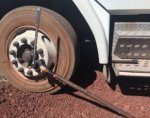
I know there are other formats, like Ozrockrat used, which brace against the neighboring lug nuts. I might have to get one of those. But, in the mean time, I had to resort to the old fashioned method. The 3/4-inch-drive breaker bar with a good old fashioned cheater extension. Archimedes would have been proud, because this seems to work. I was only testing the ability to loosen these, for now. I'll do the actual removal in the morning.

Ours is a 1997 E450 with a Road Rescue box. 14' length. We have: a shower; toilet with black tank; sink with grey tank; 30 gallon fresh water tank; 6 gallon electric/heat exchanger water heater; 2 burner propane stovetop; 110 a/c; diesel wabasto heater; inverter; external mount i3000 Honda generator; closet; microwave; external vented stove hood; sofa that folds out to queen bed; and pull out pantry cabinet; outside shower; outside high pressure propane outlet for grill; and awning. Also on the gen mount is a spare fuel can; spare tire; and 2 bike mount. We did 6300 miles from PA to Arizona and back last fall with one flat front tire.
patoz
Expedition Leader
Ours is a 1997 E450 with a Road Rescue box. 14' length. We have: a shower; toilet with black tank; sink with grey tank; 30 gallon fresh water tank; 6 gallon electric/heat exchanger water heater; 2 burner propane stovetop; 110 a/c; diesel wabasto heater; inverter; external mount i3000 Honda generator; closet; microwave; external vented stove hood; sofa that folds out to queen bed; and pull out pantry cabinet; outside shower; outside high pressure propane outlet for grill; and awning. Also on the gen mount is a spare fuel can; spare tire; and 2 bike mount. We did 6300 miles from PA to Arizona and back last fall with one flat front tire.
Not to hijack Ross's thread, but the Honda EU3000i is what I'm planning on using also. Have you discovered any problems with using it, and does it meet your needs as far as the appliances you have?
I would love to see any pictures you have of how you mounted it.
Similar threads
- Replies
- 1
- Views
- 618
- Replies
- 0
- Views
- 302
- Replies
- 0
- Views
- 443
- Replies
- 6
- Views
- 1K
